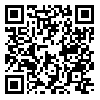Volume 7, Issue 2 (2016)
JMBS 2016, 7(2): 40-50 |
Back to browse issues page
Abstract: (12681 Views)
According to the novel achievements, nanotopography and steric geometry of the microenvironment around the cells have a drastic role on their fates. Hence, fabrication of biocompatible nanostructures as the scaffolds for the cell culture and in the next step, accurate determination of their physical and geometrical characteristics is widely considered. Despite of broad utilization of Atomic Force Microscopy to investigate topological traits of sophisticated nanopatterns; its capability to characterize electrospun nanofibers has not been studied inquiringly. In the present research, chitosan nanofibers which were successfully electrospun at the optimized conditions were then evaluated using Scanning Electron Microscopy (SEM) and Atomic Force Microscopy (AFM) respectively. The results suggested that recruitment of both of these techniques have their own advantages and disadvantages. As the first noticeable issue, while the sample preparation and scanning procedure in SEM imaging may disrupt native structure of fibers, probing the sample by AFM doesn't need any pre-imaging treatment. The main application of SEM in analysis of nanofibrillar structures is the rapid survey of nanofibers shape, orientation, diameter and consistency. In the other side, three dimensional imaging by AFM makes it possible to determine whole surface roughness, roughness along fibers and woven tissue thickness. Furthermore, regarding some technical advices, AFM can be used to estimate nanofibers average diameter as well as SEM.
Article Type: Research Paper |
Subject:
Biophysics
Received: 2015/06/16 | Accepted: 2016/02/6 | Published: 2016/09/22
Received: 2015/06/16 | Accepted: 2016/02/6 | Published: 2016/09/22
| Rights and permissions | |
 |
This work is licensed under a Creative Commons Attribution-NonCommercial 4.0 International License. |


